Lake Bled, which is situated in northwest Slovenia at the foot of the Julian Alps, is one of Slovenia’s most picturesque natural wonders. The mineral-rich emerald green waters surround a small island with a baroque church and café specializing in the art of potica baking. 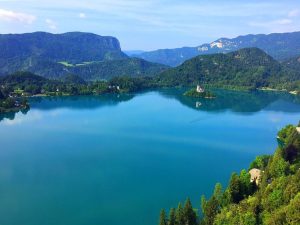
After a twisty ride up and over Vršič Pass, we reached the waterfront where we boarded a small, motorless, wooden boat called a pletna, rowed by a local. We admired the lake’s unmeasurable beauty and tranquility. Once we arrived at the island about 10 minutes later, we ascended 99 steps to the café to bake our very own poticas. A local woman taught us how to make the traditional Slovenian dessert by first showing us the steps in the process and then setting us free and helping out us when needed.
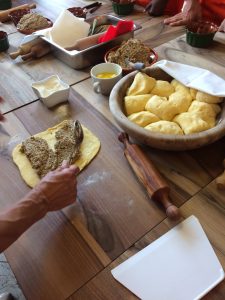
 First, we each floured a space on the wooden table, took a pre-portioned piece of dough, and formed it into a rectangular shape. We then rolled it out thin with a rolling pin until the proper size and thickness was reached. Next, we took a few heaping spoonfuls of walnut filling and spread it evenly on the dough. Then, we sprinkled finely chopped walnuts on top and attempted to roll the dough and filling as perfectly as our instructor had.
First, we each floured a space on the wooden table, took a pre-portioned piece of dough, and formed it into a rectangular shape. We then rolled it out thin with a rolling pin until the proper size and thickness was reached. Next, we took a few heaping spoonfuls of walnut filling and spread it evenly on the dough. Then, we sprinkled finely chopped walnuts on top and attempted to roll the dough and filling as perfectly as our instructor had.
 Somehow, mine stayed together and ended up fitting inside the mold. But if the rolls were too long, the extra length was sliced off made into little potica cookies. Before placing the rolled dough inside the mold, we spread a generous amount of melted butter inside to prevent the potica from sticking.
Somehow, mine stayed together and ended up fitting inside the mold. But if the rolls were too long, the extra length was sliced off made into little potica cookies. Before placing the rolled dough inside the mold, we spread a generous amount of melted butter inside to prevent the potica from sticking.  We then gently placed the dough into the mold and punched a few holes into it before it was put in the oven.
We then gently placed the dough into the mold and punched a few holes into it before it was put in the oven.
While we waited for our potica, each of us was offered a refreshing glass of elderflower water with a walnut and tarragon potica sample. The walnut version, which is the most common, was slightly sweet and seemed to be the favorite out of the two. The savory tarragon slice was a bit unusual, but good in its own way. Next, we then walked to the church, toured the interior, and we each rang the bell and made a silent wish. Before long, the church was swarming with tourists so we exited the building and walked near the water, admiring the lake’s beauty and hoping to spot a swan.
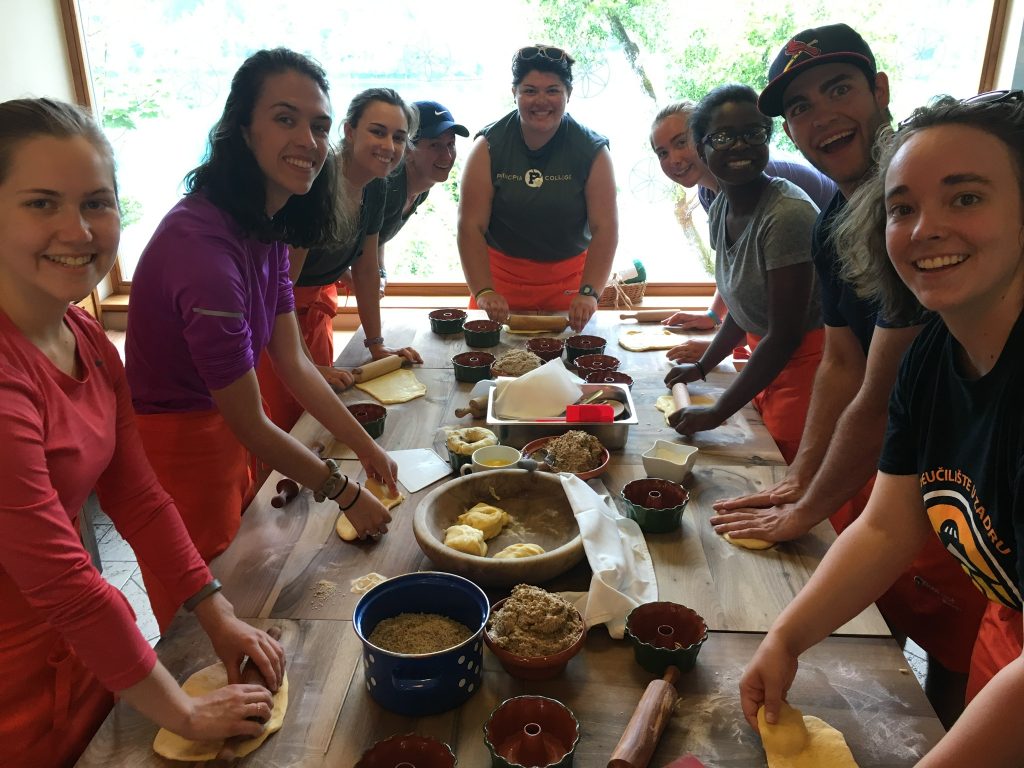 About an hour later, our miniature poticas were ready. They tasted incredibly delicious and paired perfectly with a latte, conveniently available at the café inside the store. Now that we each have our own mold, we can share this traditional dish with our family and friends. Maybe one of us will get around to baking every one of the 80 varieties!
About an hour later, our miniature poticas were ready. They tasted incredibly delicious and paired perfectly with a latte, conveniently available at the café inside the store. Now that we each have our own mold, we can share this traditional dish with our family and friends. Maybe one of us will get around to baking every one of the 80 varieties!
-Jolee
Jolee Keplinger, a sophomore, is majoring in mass communication with a minor in sustainability. Her hobbies include blogging, cooking, and anything involving art. She’s known as a foodie so it’s no surprise that her cultural presentation topic is Slovene cuisine.





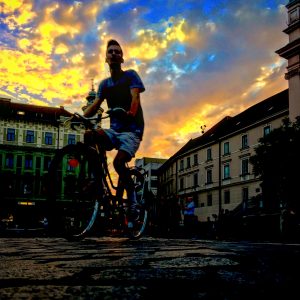
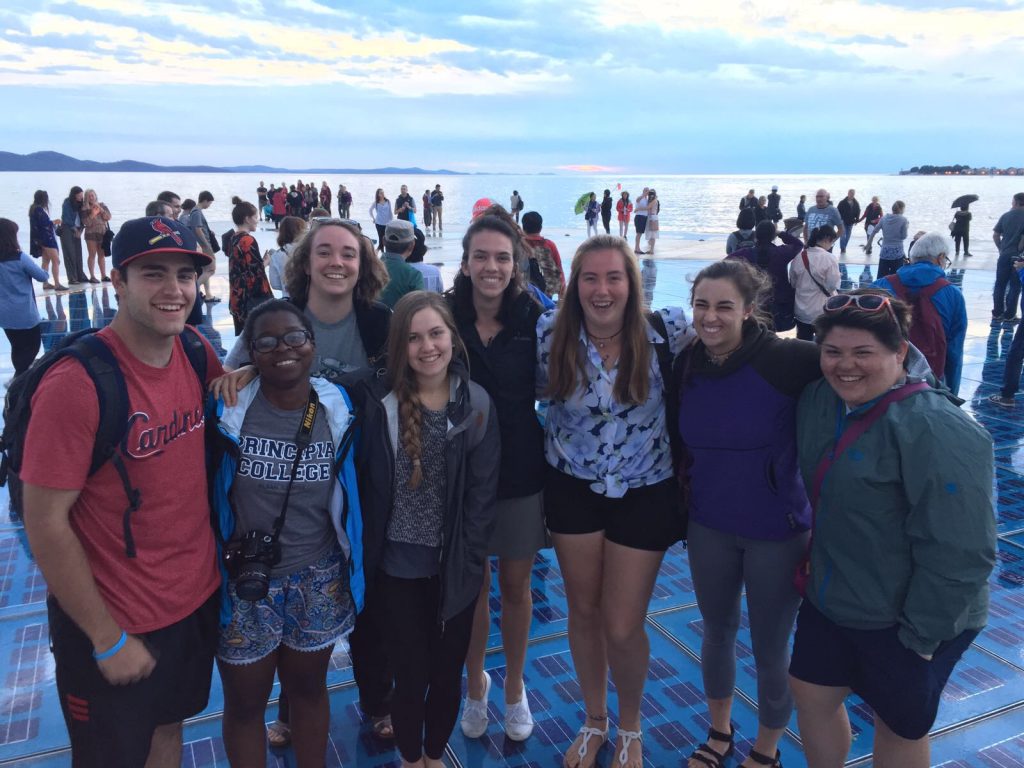 As a group, we learned to ask the right questions to find the lesser-known treasures in each place that we visited. We navigated local markets, fought over who found the most delicious (and best priced) gelato, and talked to locals to learn about how much they loved their corner of the world. While our class in the spring gave us a background understanding of Slovenia and its culture, it was only through our in-country explorations that we developed a true understanding of what it means to be Slovenian.
As a group, we learned to ask the right questions to find the lesser-known treasures in each place that we visited. We navigated local markets, fought over who found the most delicious (and best priced) gelato, and talked to locals to learn about how much they loved their corner of the world. While our class in the spring gave us a background understanding of Slovenia and its culture, it was only through our in-country explorations that we developed a true understanding of what it means to be Slovenian.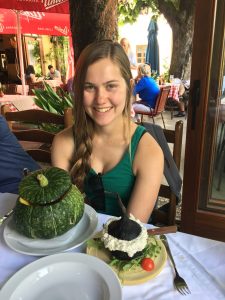
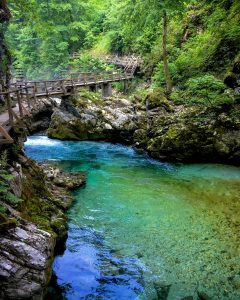
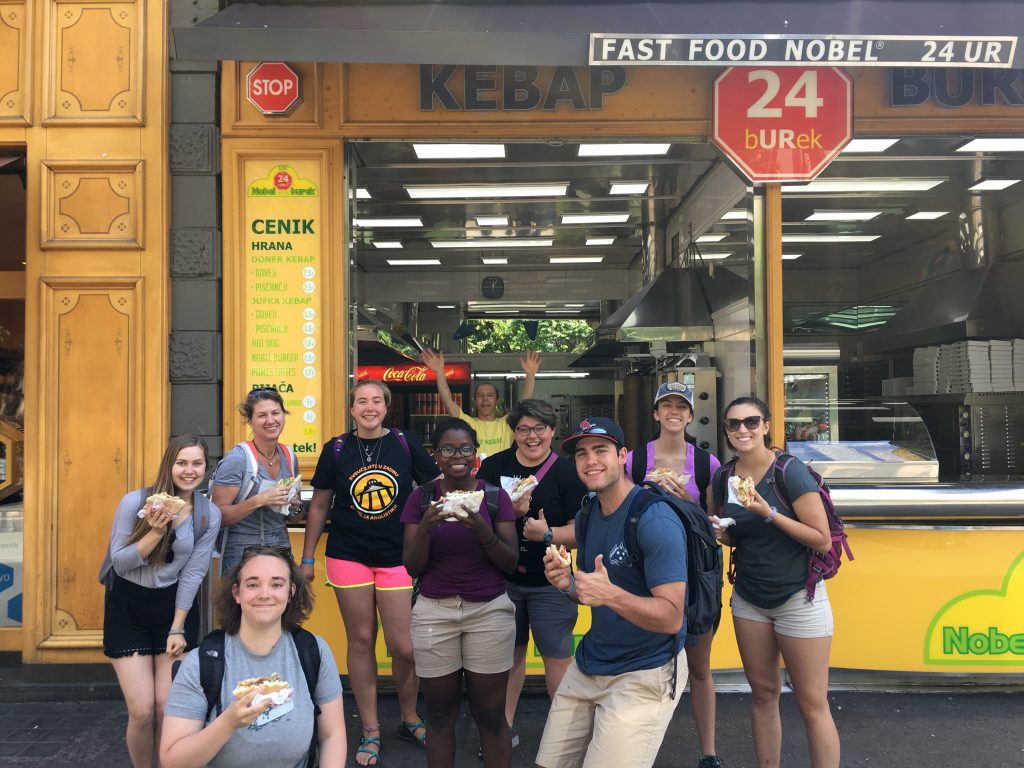




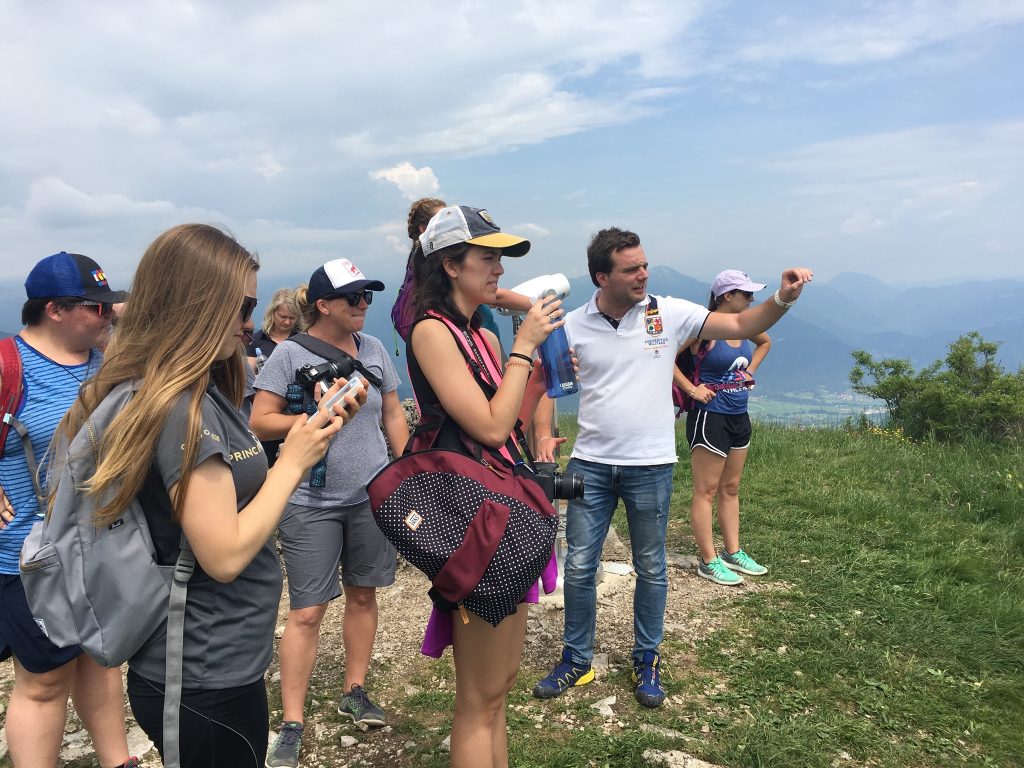

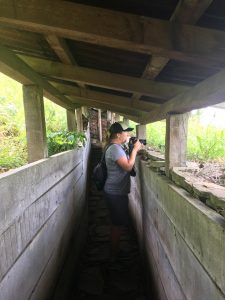
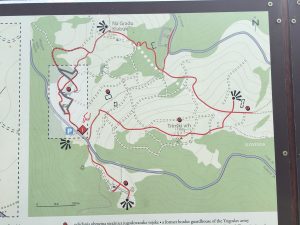 Yet, who knows if Slovenia would be its own nation today if history hadn’t played out the way it did? I cannot say, but I do know that I felt honored to walk along the Walk of Peace, leaving with the mountains and a little more peace in my own heart.
Yet, who knows if Slovenia would be its own nation today if history hadn’t played out the way it did? I cannot say, but I do know that I felt honored to walk along the Walk of Peace, leaving with the mountains and a little more peace in my own heart.
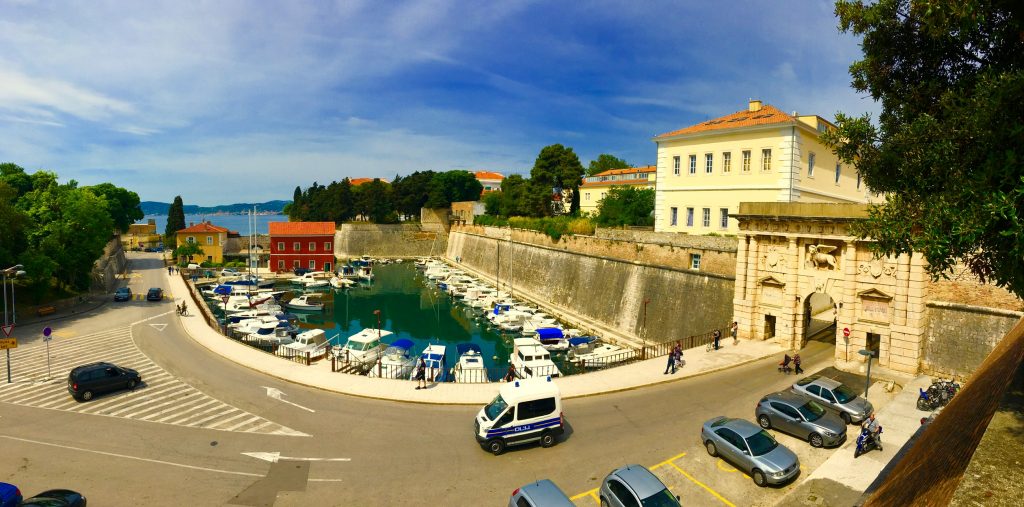

 As a joint class we discussed the novel from our two different perspectives. We talked about why we thought the novel has been chosen to be republished by Amazon Crossing (Amazon’s translation branch) and what themes made it attractive to a global audience. We discussed the themes of hopping between time periods, war, and forbidden love, and how these would be attractive to readers on the global market. One local student voiced her opinion that she was tired of the Croatia constantly being connected to war in their literature because she feels it does not accurately reflect the current state of of the country.
As a joint class we discussed the novel from our two different perspectives. We talked about why we thought the novel has been chosen to be republished by Amazon Crossing (Amazon’s translation branch) and what themes made it attractive to a global audience. We discussed the themes of hopping between time periods, war, and forbidden love, and how these would be attractive to readers on the global market. One local student voiced her opinion that she was tired of the Croatia constantly being connected to war in their literature because she feels it does not accurately reflect the current state of of the country.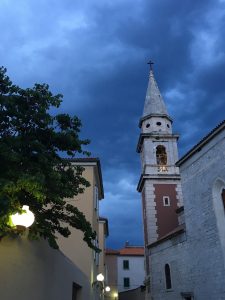 In the end, it was a great discussion with a lot learned on both sides. It was exciting to talk about the book with other students with a completely different view on the topic, as well as one of the translators of the novel itself. Thank you for hopping back in time with me to a discussion about a novel that hops around in time.
In the end, it was a great discussion with a lot learned on both sides. It was exciting to talk about the book with other students with a completely different view on the topic, as well as one of the translators of the novel itself. Thank you for hopping back in time with me to a discussion about a novel that hops around in time.

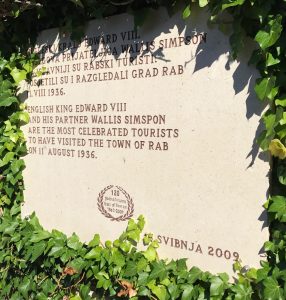
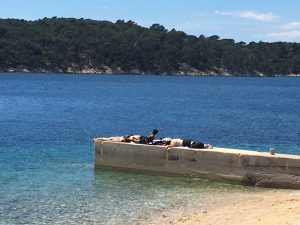

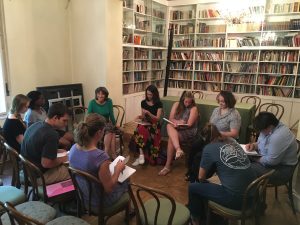 Ifigenija Simonović is a modernist poet, no rhymes no rules, as well as the president of the Slovene branch of PEN, an organization that defends the rights of writers worldwide. You might say it’s like amnesty international but for poets, essayists, novelists, and writers of all kinds. She encouraged us to gather the chairs in the cozy lecture hall of the Slovene Writers Association into a big circle. It made us feel more comfortable with asking questions as she took us through a wandering chat about everything from Slovene literary history to the rash of foreign coloring books that have swept through the nation just as forcefully as in the United States.
Ifigenija Simonović is a modernist poet, no rhymes no rules, as well as the president of the Slovene branch of PEN, an organization that defends the rights of writers worldwide. You might say it’s like amnesty international but for poets, essayists, novelists, and writers of all kinds. She encouraged us to gather the chairs in the cozy lecture hall of the Slovene Writers Association into a big circle. It made us feel more comfortable with asking questions as she took us through a wandering chat about everything from Slovene literary history to the rash of foreign coloring books that have swept through the nation just as forcefully as in the United States. 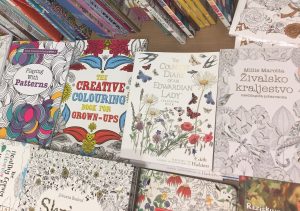
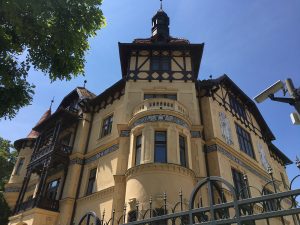 Speaking of the States, we can’t help showing a picture of the U.S. Embassy, a neighbor to the Slovene Writers’ Association.
Speaking of the States, we can’t help showing a picture of the U.S. Embassy, a neighbor to the Slovene Writers’ Association.
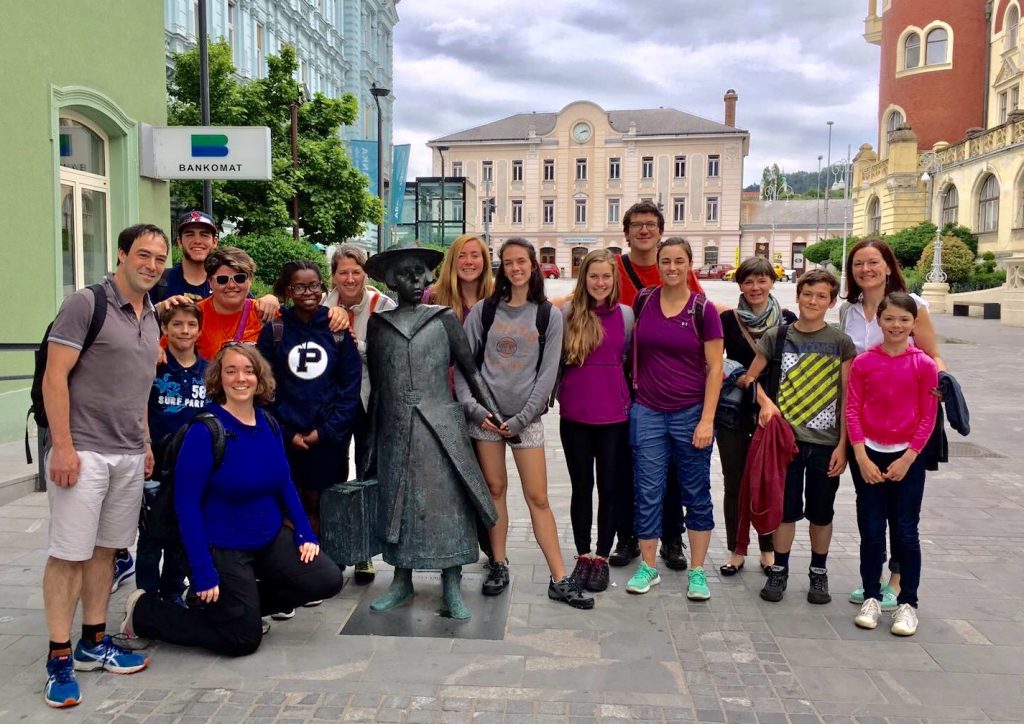
 After an hour-long drive we met our hosts at in the cafe at Hotel Evropa where many of us drank the famous Turkish coffee before headingto Pokrajinski Muzej. At the museum, we toured the castle/palace where the counts of Celje used to live. The most recent castle was built on top of an old Roman road and fortifications of the city of Celeia. During Roman rule, the structure was used as barracks and for military protection. Signs of Roman heating and sewage systems are on display in a below-ground exhibition of Roman ruins found and left in situ. At one point our tour group was standing in what had been the moat. As proof, the castle ruins show three ground floors because each time it was rebuilt (three distinct times after conquests by such enemies as Attila the Hun) the ground floor was built higher and higher because of the rising water level. (After our museum visit our hosts showed us the new Celje information center, where more Roman ruins are displayed in situ in the city center. They were discovered in 2015 when the town was upgrading a pedestrian area.)
After an hour-long drive we met our hosts at in the cafe at Hotel Evropa where many of us drank the famous Turkish coffee before headingto Pokrajinski Muzej. At the museum, we toured the castle/palace where the counts of Celje used to live. The most recent castle was built on top of an old Roman road and fortifications of the city of Celeia. During Roman rule, the structure was used as barracks and for military protection. Signs of Roman heating and sewage systems are on display in a below-ground exhibition of Roman ruins found and left in situ. At one point our tour group was standing in what had been the moat. As proof, the castle ruins show three ground floors because each time it was rebuilt (three distinct times after conquests by such enemies as Attila the Hun) the ground floor was built higher and higher because of the rising water level. (After our museum visit our hosts showed us the new Celje information center, where more Roman ruins are displayed in situ in the city center. They were discovered in 2015 when the town was upgrading a pedestrian area.) During medieval times, the castle and its walls sported marble representative of the Roman era. Marble statues were displayed in the house as a form of decoration. During the tour, we each got to put on the helmet of a knight, which was heavy, and hold a shield and sword. Overall, there were 18 counts of Celje, and their skulls (carbon dated for identification purposes) can be found in this museum in an eerie gallery.
During medieval times, the castle and its walls sported marble representative of the Roman era. Marble statues were displayed in the house as a form of decoration. During the tour, we each got to put on the helmet of a knight, which was heavy, and hold a shield and sword. Overall, there were 18 counts of Celje, and their skulls (carbon dated for identification purposes) can be found in this museum in an eerie gallery.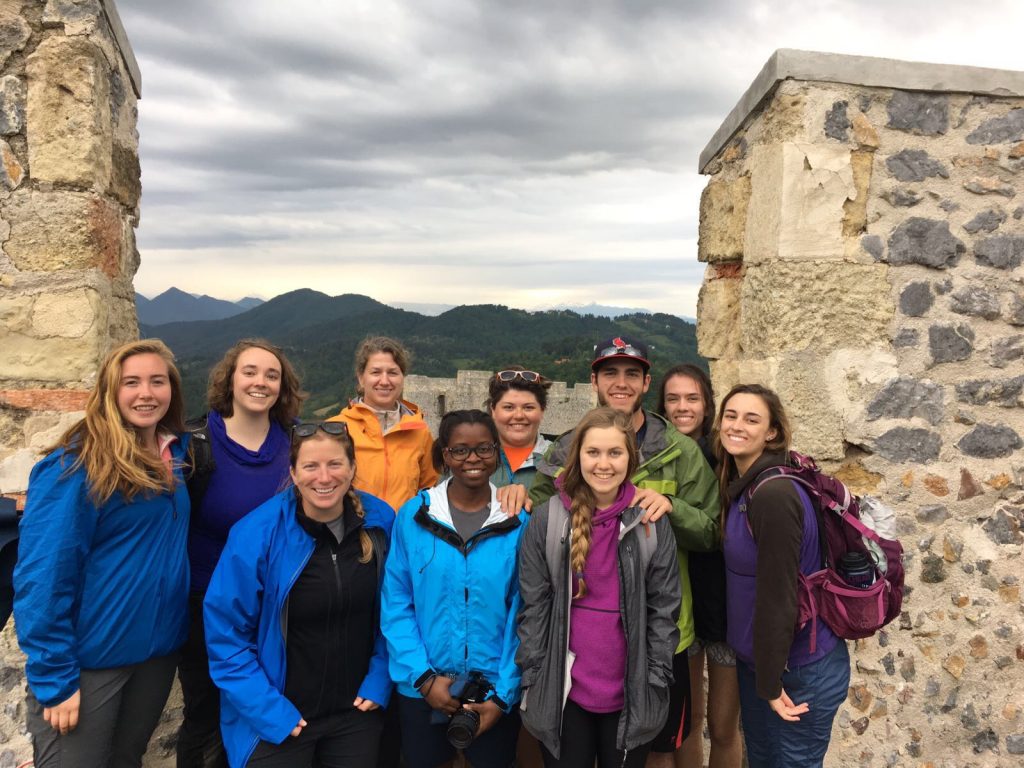 Now the story of Frederick and Veronika mirrors that of Romeo and Juliet to a certain degree. Frederick was a count, child of Herman II, while Veronika was just a lowly peasant. After the death of his wife, Frederick wanted to be with Veronica but his father disapproved. Veronika got accused of witchcraft and was brought in for trial. After her escape, she lived with monks for a while and then later was captured and drowned by Herman II’s army.
Now the story of Frederick and Veronika mirrors that of Romeo and Juliet to a certain degree. Frederick was a count, child of Herman II, while Veronika was just a lowly peasant. After the death of his wife, Frederick wanted to be with Veronica but his father disapproved. Veronika got accused of witchcraft and was brought in for trial. After her escape, she lived with monks for a while and then later was captured and drowned by Herman II’s army.
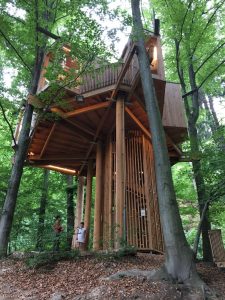 The highlight of the day for me was the tree house in the city forest. After a twenty-minute walk from lunch followed by a twenty-minute hike up hill, we arrived on the site of the tree house. It is a beautiful place in the middle of the woods of Douglas-fir trees. We ate ice cream brought by our hosts and listened to Erazum and Oskar play clarinet and guitar. Brooke played guitar, and then Oskar showed us some break dance moves.
The highlight of the day for me was the tree house in the city forest. After a twenty-minute walk from lunch followed by a twenty-minute hike up hill, we arrived on the site of the tree house. It is a beautiful place in the middle of the woods of Douglas-fir trees. We ate ice cream brought by our hosts and listened to Erazum and Oskar play clarinet and guitar. Brooke played guitar, and then Oskar showed us some break dance moves.
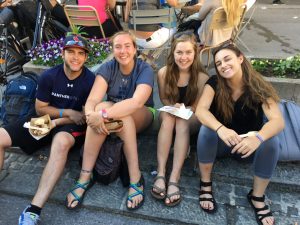 The guy in the restaurant greeted us in Slovene, and we responded in the limited Slovene that we’ve learned before letting him know that we speak English. He hesitantly responded by telling us that he knew very little English. While this didn’t seem convenient, we agreed that we would just find a way to communicate and get our cevappi.
The guy in the restaurant greeted us in Slovene, and we responded in the limited Slovene that we’ve learned before letting him know that we speak English. He hesitantly responded by telling us that he knew very little English. While this didn’t seem convenient, we agreed that we would just find a way to communicate and get our cevappi.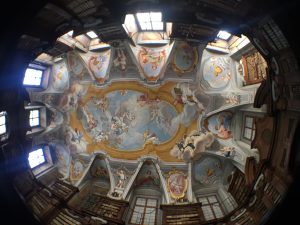 library that we visited. I don’t remember hearing the name, but I zone out a lot. (The blog editor knows it’s the Semenska Knijzica, a Baroque library that at one time held a 1:1ratio of books to citizens of Ljbuljana.) I’m not kidding when I say that this was the coolest library I’ve ever stepped foot in. Books are already cool, but I’m telling you that this place made books seem cool
library that we visited. I don’t remember hearing the name, but I zone out a lot. (The blog editor knows it’s the Semenska Knijzica, a Baroque library that at one time held a 1:1ratio of books to citizens of Ljbuljana.) I’m not kidding when I say that this was the coolest library I’ve ever stepped foot in. Books are already cool, but I’m telling you that this place made books seem cool While the castle was more touristy than I was expecting—there were glossy signs on every door, railings and glass windows all over the place, just stuff like that—the view from the top tower was special. As the highest point in a very not tall city, the view from the tower allows you to see one-third of the entire country of Slovenia. Landscape and rooftops stretch on for miles and miles, and there’s even a faint glimpse of Austria to the northwest and Croatia to the southwest. On a clear day you can see Mount Triglav, the country’s highest peak.
While the castle was more touristy than I was expecting—there were glossy signs on every door, railings and glass windows all over the place, just stuff like that—the view from the top tower was special. As the highest point in a very not tall city, the view from the tower allows you to see one-third of the entire country of Slovenia. Landscape and rooftops stretch on for miles and miles, and there’s even a faint glimpse of Austria to the northwest and Croatia to the southwest. On a clear day you can see Mount Triglav, the country’s highest peak.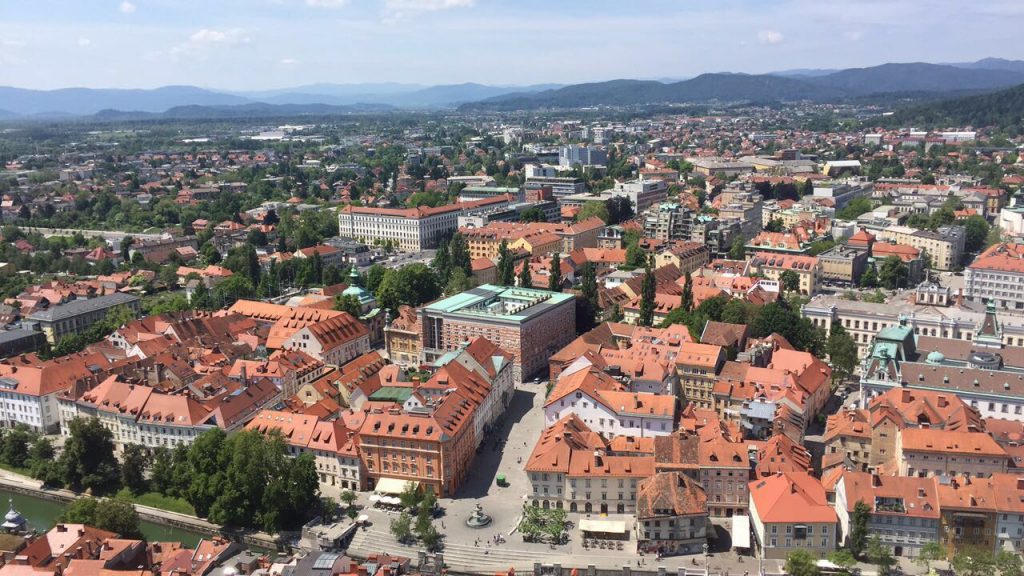
 I don’t think anyone chose to eat a meal that wasn’t at the Odprta Kuhna (Open Kitchen). My two meals consisted of filet mignon and potatoes (lunch), roast pork and potatoes (dinner), and double chocolate strawberry gelato (dessert) across the river at Kakao.
I don’t think anyone chose to eat a meal that wasn’t at the Odprta Kuhna (Open Kitchen). My two meals consisted of filet mignon and potatoes (lunch), roast pork and potatoes (dinner), and double chocolate strawberry gelato (dessert) across the river at Kakao.
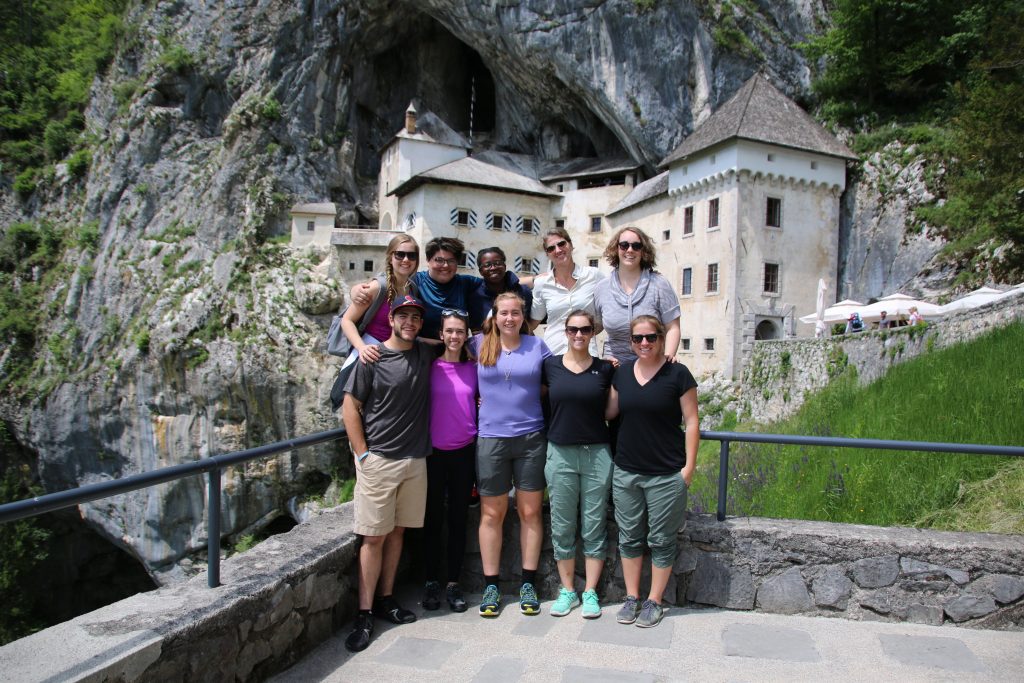 Next we took a 20 minute drive to Predjama Castle. This incredible castle is situated inside a cave! Once inside, you can see how the builders used the natural rock as the back wall of the castle and how effortlessly the manmade walls connect to the natural rock. We also learned about some of the people who lived inside the castle. The most famous owner, Erasmus (Erazem), holed up in the castle for over a year to avoid the army that awaited him outside. He was able to send servants out a secret passageway to get supplies. Ultimately he was betrayed by one of his servants who, when Erasmus was on the toilet, signaled to the army outside using a candle. The army then shot a cannon into the bathroom, causing it to collapse and killing Erasmus. The castle itself has an incredible view of the valley and provided a unique cultural and historical experience for us all!
Next we took a 20 minute drive to Predjama Castle. This incredible castle is situated inside a cave! Once inside, you can see how the builders used the natural rock as the back wall of the castle and how effortlessly the manmade walls connect to the natural rock. We also learned about some of the people who lived inside the castle. The most famous owner, Erasmus (Erazem), holed up in the castle for over a year to avoid the army that awaited him outside. He was able to send servants out a secret passageway to get supplies. Ultimately he was betrayed by one of his servants who, when Erasmus was on the toilet, signaled to the army outside using a candle. The army then shot a cannon into the bathroom, causing it to collapse and killing Erasmus. The castle itself has an incredible view of the valley and provided a unique cultural and historical experience for us all!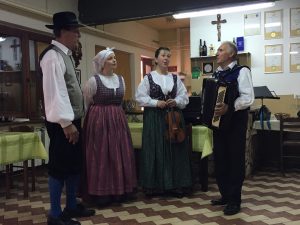 We were also greeted traditionally by being given a piece of homemade bread which we then dipped in salt and ate. It was so fun to walk in while traditional music was being played for us live. Accordion, fiddle, and clarinet. We then sat down and were given more bread, water, and fresh apple juice! We continued to eat cabbage soup (which tasted like sauerkraut), homemade mashed potatoes, sausage, and porks slices from their family-owned pigs while the live music continued.
We were also greeted traditionally by being given a piece of homemade bread which we then dipped in salt and ate. It was so fun to walk in while traditional music was being played for us live. Accordion, fiddle, and clarinet. We then sat down and were given more bread, water, and fresh apple juice! We continued to eat cabbage soup (which tasted like sauerkraut), homemade mashed potatoes, sausage, and porks slices from their family-owned pigs while the live music continued.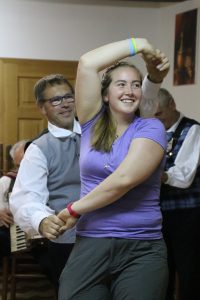 The Slovenes then began to perform traditional dances for us. It was so fun to hear them sing and watch them dance! Once they finished, a man came up to me and asked me to dance! I was taken for a spin, or I should say many, as I was led through one of the traditional dances. Almost all of us danced with one of the individuals we met and we all had a great time! I was sad to leave the festivities, but beyond grateful for the experience. It was a day I won’t soon forget and a memory I will keep forever!
The Slovenes then began to perform traditional dances for us. It was so fun to hear them sing and watch them dance! Once they finished, a man came up to me and asked me to dance! I was taken for a spin, or I should say many, as I was led through one of the traditional dances. Almost all of us danced with one of the individuals we met and we all had a great time! I was sad to leave the festivities, but beyond grateful for the experience. It was a day I won’t soon forget and a memory I will keep forever!